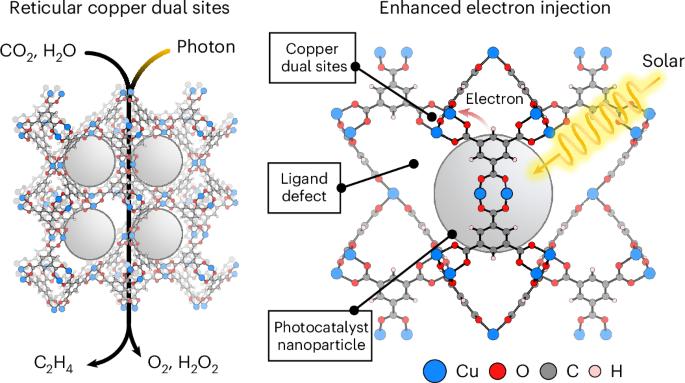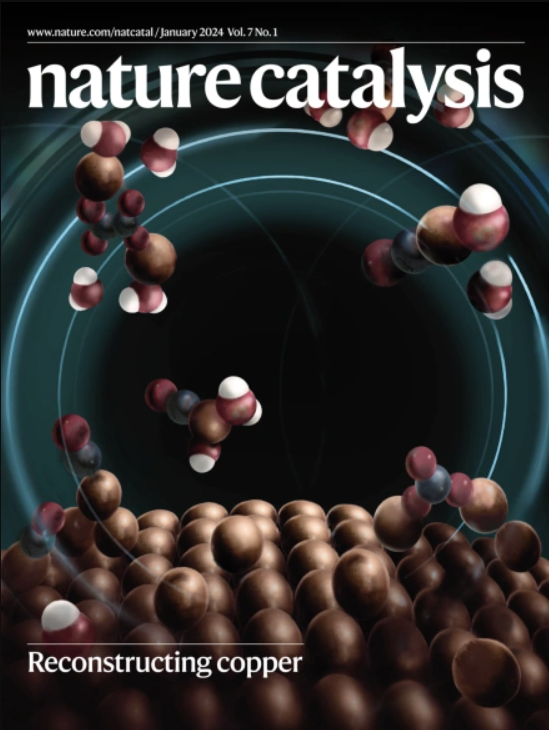Reticular copper dual sites embedded with semiconductor particles for selective CO2-to-C2H4 photoreduction
IF 44.6
1区 化学
Q1 CHEMISTRY, PHYSICAL
引用次数: 0
Abstract
Dual sites, positioned through atomically precise proximity coordination for C–C coupling, serve as an exemplary platform for CO2-to-C2H4 conversion. Nonetheless, their surface-only distribution results in inefficient photogenerated electron injection via long-range migration from the bulk phase, leading to inadequate site charge to drive the consecutive electron transfers for C2H4 synthesis. Here we demonstrate a reticular dual-site photocatalyst design by embedding semiconductor units (TiO2, polymeric carbon nitride or WO3·H2O) within ligand-defective copper-based metal–organic frameworks (CuBTC-D/PC). This system demonstrates a 75.5% selectivity in converting CO2 to C2H4 with H2O as the electron donor. The reticular copper dual sites facilitate short-range photogenerated electron transfer from the photocatalyst to active sites, ensuring a sufficient electron concentration for all elementary steps in C2H4 conversion. Enhanced electron injection allows for high C2H4 selectivity even under low-intensity irradiation (~0.4 Sun), demonstrating suitability for solar-driven applications. This work establishes the feasibility of CO2 photoreduction to C2H4 as a primary product, providing insights into multi-electron CO2 photoreduction. The formation of multi-carbon products in photocatalytic CO2 reduction has been limited by the supply of sufficient excited electrons to C–C coupling active sites. Here Cu2 sites introduced into metal–organic frameworks with semiconductor photocatalyst-filled pores allow multi-electron transfer and improved solar efficiency towards C2H4.


嵌入半导体粒子的网状铜双位点选择性co2到c2h4光还原
通过原子精确的C-C耦合接近协调定位的双位点,可作为co2到c2h4转换的示范平台。尽管如此,它们的表面分布导致光生电子从体相通过远程迁移注入效率低下,导致没有足够的位置电荷来驱动C2H4合成的连续电子转移。本文通过在配体缺陷的铜基金属有机框架(CuBTC-D/PC)中嵌入半导体单元(TiO2、聚合氮化碳或WO3·H2O),展示了一种网状双位点光催化剂设计。该体系以H2O为电子供体,将CO2转化为C2H4的选择性为75.5%。网状铜双位促进了从光催化剂到活性位点的短程光生电子转移,确保了C2H4转化的所有基本步骤都有足够的电子浓度。增强的电子注入允许高C2H4选择性,即使在低强度照射下(~0.4太阳),证明适合太阳能驱动的应用。本工作确立了CO2光还原为C2H4作为初级产物的可行性,为多电子CO2光还原提供了新的见解。
本文章由计算机程序翻译,如有差异,请以英文原文为准。
求助全文
约1分钟内获得全文
求助全文
来源期刊

Nature Catalysis
Chemical Engineering-Bioengineering
CiteScore
52.10
自引率
1.10%
发文量
140
期刊介绍:
Nature Catalysis serves as a platform for researchers across chemistry and related fields, focusing on homogeneous catalysis, heterogeneous catalysis, and biocatalysts, encompassing both fundamental and applied studies. With a particular emphasis on advancing sustainable industries and processes, the journal provides comprehensive coverage of catalysis research, appealing to scientists, engineers, and researchers in academia and industry.
Maintaining the high standards of the Nature brand, Nature Catalysis boasts a dedicated team of professional editors, rigorous peer-review processes, and swift publication times, ensuring editorial independence and quality. The journal publishes work spanning heterogeneous catalysis, homogeneous catalysis, and biocatalysis, covering areas such as catalytic synthesis, mechanisms, characterization, computational studies, nanoparticle catalysis, electrocatalysis, photocatalysis, environmental catalysis, asymmetric catalysis, and various forms of organocatalysis.
 求助内容:
求助内容: 应助结果提醒方式:
应助结果提醒方式:


